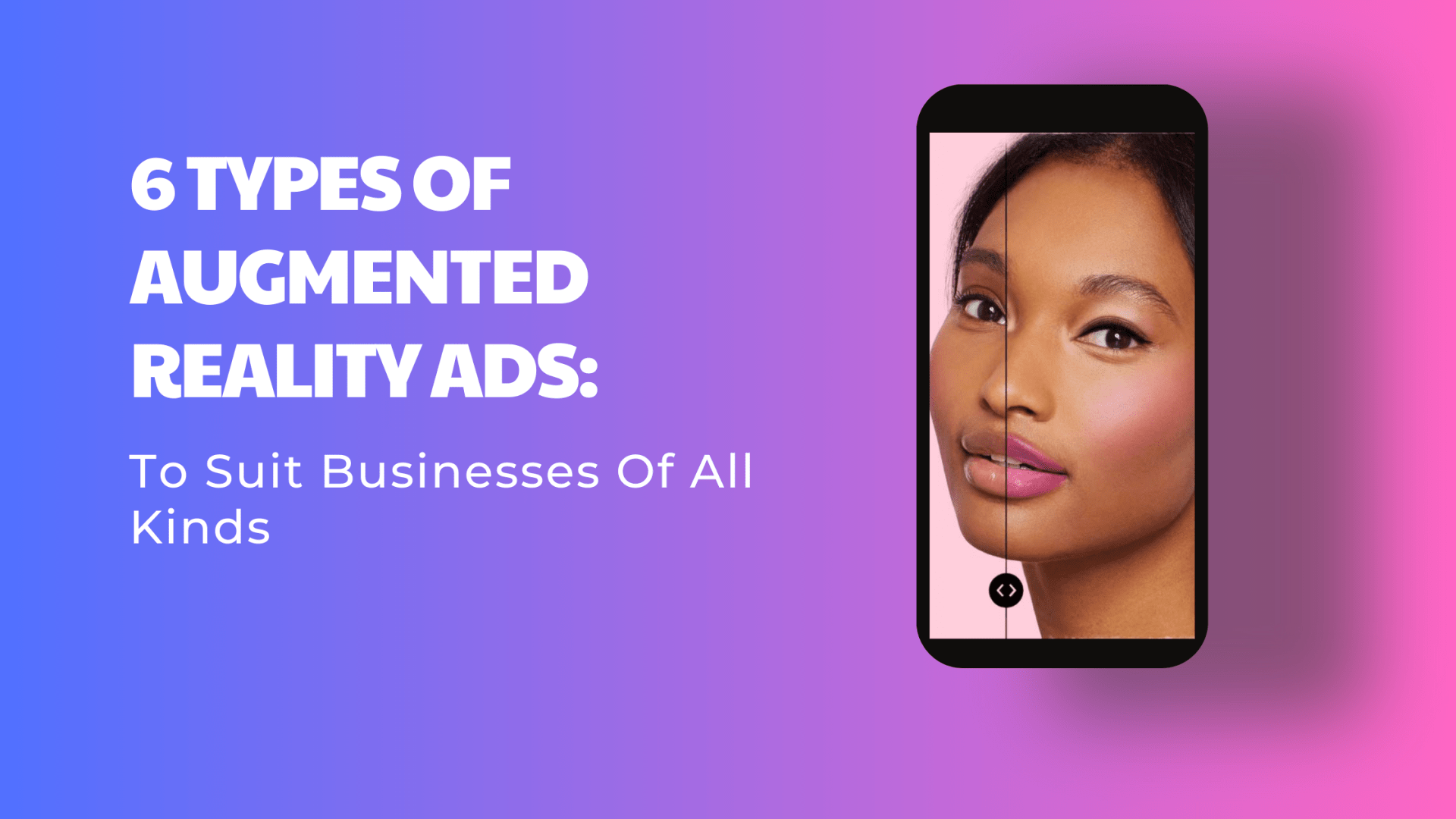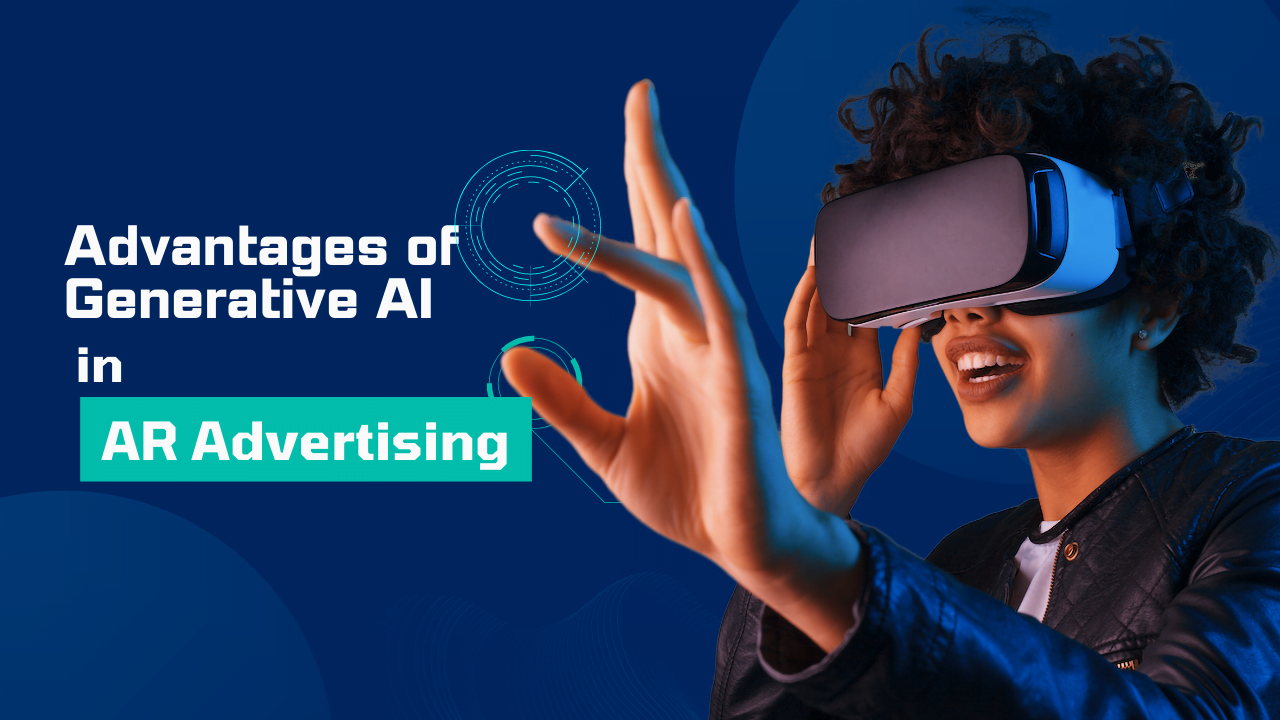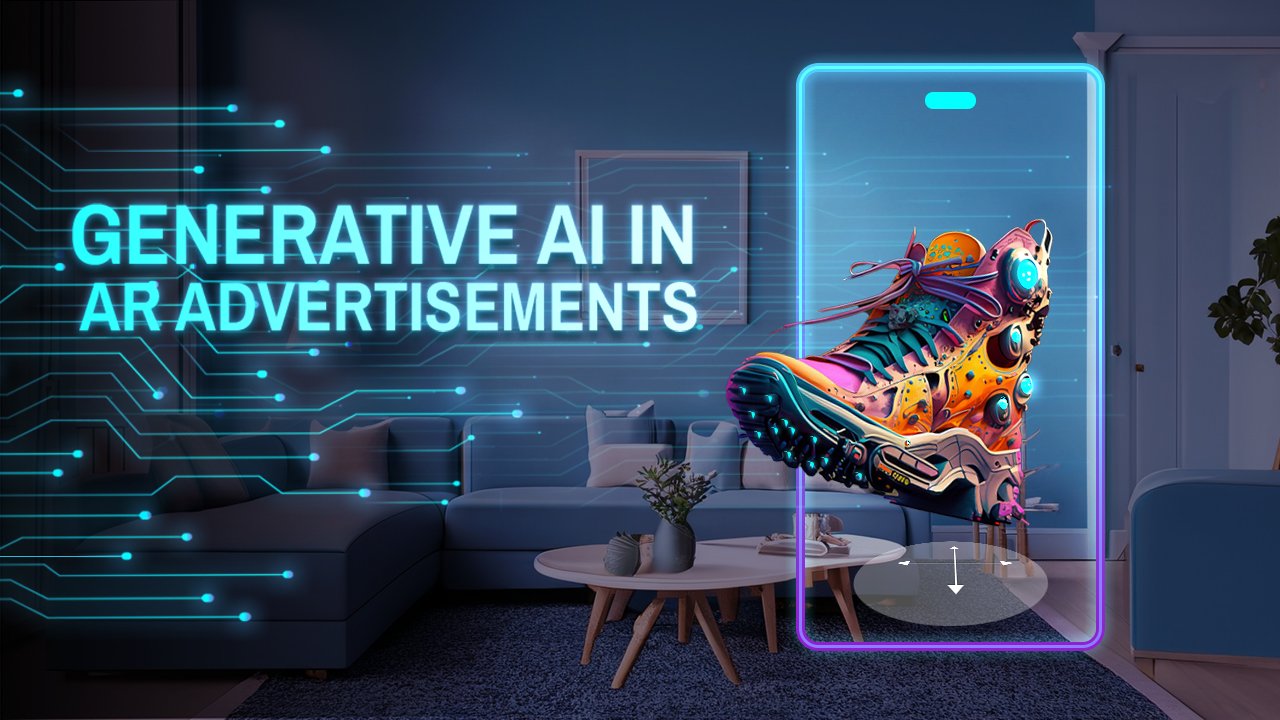A survey by IBM revealed that 35% of business leaders think that generative AI is one of the most popular emerging technologies. They believe it will bring significant changes to business processes, including marketing.
Along the same lines, a Mckinsey analysis found that over 400 advanced use cases showed AI would contribute the most to marketing.
On the other hand, the AR Advertising market is projected to reach US$6.72 billion by 2027 from an expected US$4.30 billion in 2023, with an annual growth rate of 11.80%. (Statista)
A study comprising a survey of 43 agency executives found that over two-thirds, i.e., 67%, of agencies want to see more AR and VR in digital advertising campaigns. (Media Post)
The above statistics show how AR and AI will transform advertising in the next few years. It is opening new opportunities and possibilities, and businesses are vying for its deployment to make the most of it.
That is why, here, we will explore how Generative AI and AR advertising work together to help businesses amplify their advertising campaigns for new levels of success.
Source: IBM – Global Tech Investment Prediction Report 2022
Understanding Generative AI and its Interactions with AR Advertisements
Generative AI is a branch of Artificial Intelligence capable of generating content autonomously, hence the name “Generative”.
It uses machine learning algorithms to understand users’ requirements and generate content for the same. Depending upon the application, the content can be in any format such as text, image, video, 3D graphic models, animations, etc.
AR advertisements, on the other hand, are ads that place digital brand elements right into the users’ real world. Allowing users to see and interact with the elements and connect with the brand on deeper cognitive levels.
When integrated with AR advertising, Generative AI helps advertisers create eye-catching and realistic advertisements that resonate with the brand identity and the target audience. It produces visually stunning and realistic content for an immersive AR advertising experience for an engaging and memorable experience.
In an industry-revolutionizing move, Vossle integrated generative AI capability into its AR platform. Using the Vossle platform, advertisers can generate high-quality AR advertisement content for any online or offline advertising channel.
AI-Powered AR Ads For Every Advertising Channel

AR advertisements are suitable across multimedia advertising formats such as Online Ads, Print Ads, and OOH advertising. In this section, we will discuss the avenues available for your AR advertising when created with Vossle.
Online Advertising: Surprising the Surfers
In the digital advertising space, Augmented Reality (AR) has become a powerful tool for advertisers, offering interactive experiences that stand out from static ads. AR advertisements integrated into digital ad units on websites and social media platforms create unique and immersive connections with online audiences, enhancing brand engagement.
Vossle’s inline AR advertising (shown below) is a groundbreaking solution that seamlessly integrates AR ads onto any webpage.
When you create an AR advertisement using Vossle, you get a link to the AR Ad experience. Use this link to embed your AR ad on any website. As soon the user lands on the website, the ad automatically gets activated augmenting users’ surroundings with interactive digital 3D elements.
Users can engage with these elements as if they were physically present, blurring the lines between the digital and physical worlds.
AR ads provide a captivating and delightful experience, leaving a lasting impression on users and setting brands apart in the competitive digital landscape. The seamless integration ensures users are exposed to rich content that complements their browsing experience, providing advertisers with a distinct advantage.
Print Advertising: Extending the Reach of AR Experiences
Print advertising remains a powerful and tangible medium for brands to connect with their audience. By integrating AR technology through Vossle’s innovative platform, advertisers can elevate their print campaigns to new heights, offering consumers an interactive and immersive experience that goes beyond traditional static advertisements.
When you create an AR advertising campaign on Vossle, you receive a unique link and a QR code that serves as a trigger for your brand’s AR experience. The QR code can be strategically placed on any offline advertising platform, such as magazines, newspapers, brochures, or flyers. This simple yet powerful integration allows readers and potential customers to access the AR experience seamlessly.
Web-based AR Experiences: Instant Access, Limitless Engagement
Vossle provides advertisers with Web-based AR experiences, also known as WebAR, which run directly within users’ pre-installed web browsers on their devices. Whether it’s a smartphone, tablet, or PC, users can immerse themselves in the AR experience without the need to install any specific application or software. This frictionless approach ensures wide user adoption, as there are no barriers to entry.
By scanning the QR code printed on the advertisement, users are transported into a captivating world of augmented reality, where they can engage with your brand in innovative ways. This ease of access and seamless integration into existing devices contribute to the success of WebAR campaigns, garnering immense reach and catching the attention of more eyeballs.
OOH Advertising: Making AR Come to Life in Public Spaces
Vossle’s AR integration opens up exciting possibilities for Out-of-Home (OOH) advertising. Placing the QR code on OOH advertising platforms such as airports, cinemas, bus shelters, and billboards allows advertisers to tap into the vast number of visitors frequenting these public spaces. The never-seen-before AR advertising experiences become irresistible to passersby, who are naturally drawn to explore and interact with the brand.
The dynamic and interactive nature of AR content captivates viewers, making the advertising campaign a standout success. Users become active participants in the brand’s story, fostering a deeper connection and driving brand recall.
Television: Enhancing Visual Appeal with AR
Television remains a popular medium for reaching broad audiences, and AR ads bring a double-layered offering to this platform. First, AR advertisements leverage stunning visuals and engaging marketing strategies to catch the viewer’s attention during commercial breaks. The incorporation of AR elements creates a memorable and impactful viewing experience.
Once the viewer’s curiosity is piqued, they eagerly scan the QR code displayed in the advertisement. This simple action unlocks a whole new level of engagement, where viewers can explore additional information, participate in interactive experiences, or access exclusive content. The seamless transition from passive viewing to active participation enhances brand engagement and fosters a lasting impression.
Moreover, the best part is that the AR ad experience so triggered has no time limit like a television ad. Users keep interacting with that brand’s AR experience even after the TV ad is long gone.
All these above-discussed advertising channels are used to deploy different types of AR advertisement. This includes markerless, marker-based, AR games, AR tryon, and others. We will discuss these different types of AR ads in the next section.
6 Types Of Augmented Reality Ads: To Suit Businesses Of All Kinds

Various types of AR advertisements have emerged, each offering unique opportunities to captivate audiences and deliver unforgettable brand experiences. Let’s delve into each of these AR ad formats, exploring what they are, how they work, their business applications, the benefits they offer, and the pivotal role played by Generative AI in enhancing these immersive campaigns.
AR Tryon Ads: Elevating Shopping Experiences
AR Tryon Ads revolutionize the way consumers shop for fashion, accessories, and beauty products by allowing them to virtually try on products through their device’s camera. Realistic 3D models of the products are superimposed onto the user’s live image, enabling a personalized and immersive fitting experience.
Users engage with the AR Tryon Ad with their device’s camera. The AR technology accurately tracks facial features or body movements with the help of AI, ensuring a seamless and lifelike try-on experience.
Businesses like fashion and beauty brands are leveraging AR Tryon Ads to offer customers digital product trials. Customers can see how products look on themselves before making a purchase.
Vossle offers its users create a diverse range of AR tryon experiences. Users can create:
- Footwear Tryons
- Headwear Tryons
- Eye-wear Tryons
- Jewelry Tryons including Ring Tryons
- Accessories Tryons like Watch Tryons
- Jacket Tryons and much more.
In AR Tryon Ads, Generative AI contributes by creating realistic and visually appealing 3D models of wearable products and enhances the overall try-on experience for users.
AR Gamified Ads: Interactive Brand Engagement
AR Gamified Ads blend entertainment and brand engagement, offering users interactive and playful experiences through AR games. Users interact with the ad to play an AR game overlaid in their real-world environment. Successful engagement can lead to rewards, discounts, or exclusive content, enticing users to participate actively.
AR gamified experiences have tons of benefits.
To start with, given the nature of the game, users enjoy engaging with such AR experience which leads to longer user engagement and brand exposure while fostering brand affinity.
Additionally, users readily share them with their peers to have a collective experience increasing the reach and virality of the ad experience. Further, the longer brand interaction also results in better memory retention boosting brand recall.
Visuals are the first and foremost aspect of any gamified experience including AR gaming ads. Interestingly, Generative AI algorithms are at the core of developing dynamic and visually captivating game elements. Additionally, it also ensures that these elements are optimized for performance and interaction.
Advertisers can generate diverse and innovative game elements with Generative AI and infuse greater enjoyability and immersiveness into the AR gaming experience.
One special benefit of Generative AI for advertisers is that it tailors game elements to align with the brand’s identity and marketing objectives. Thus, advertisers can reinforce their brand messaging and foster stronger brand associations with the audience. Unilever’s Ponds utilized the Vossle platform to create AR Gaming ads to reach out to younger audiences.
The interplay between Generative AI and AR technology opens up exciting possibilities for personalized gaming experiences. This adaptability allows for dynamic content generation, ensuring that users encounter unique and unpredictable challenges each time they engage with the AR Gamified Ads.
Given all these possibilities with Generative AI-powered, AR gaming ads bring high potential to outperform any other advertising platform.
Markerless Ads: Seamlessly Integrating with Reality
Markerless Ads utilize advanced computer vision technology to seamlessly integrate AR content into users’ real-world surroundings without the need for physical markers or QR codes.
The AR content detects and interacts with real-world surfaces and objects, overlaying digital elements naturally within the environment.
Brands create immersive and context-aware experiences that seamlessly blend with users’ surroundings, enabling innovative and captivating storytelling.
Markerless AR ads offer natural and intuitive user experiences that provide advertisers with greater creative freedom and wider possibilities. Advertisers create captivating campaigns that dynamically interact with various environments enhancing user engagement, leading to longer brand exposure and a more memorable brand experience.
Overall, markerless AR ads provide a frictionless and immersive way to connect with audiences in a contextually relevant manner.
In Markerless AR ads, Generative AI offers a crucial role. It creates complex and realistic AR elements that seamlessly integrate with the physical environment. Markerless ads utilize advanced computer vision technology to detect real-world surfaces and objects, allowing for frictionless AR experiences without the need for physical markers or QR codes.
The high-fidelity 3D models, lifelike visual effects, and interactive elements generated with AI accurately interact with the surrounding environment. With the help of datasets and deep learning techniques, Generative AI ensures that the AR elements blend naturally and intuitively with the user’s surroundings.
The technology’s ability to understand the context of the physical environment allows it to create AR content that aligns with the user’s position, orientation, and lighting conditions. This ensures that the AR experience remains seamless and coherent, enhancing the sense of presence and immersion for users.
Moreover, Generative AI empowers marketers to customize the AR elements based on the specific context and setting. This flexibility enables advertisers to create unique and context-aware AR campaigns that deliver personalized experiences to users.
Marker-based Ads: Precision and Targeted Engagement
Marker-based Ads identify specific physical markers or images in users’ real-world environment to trigger AR content. Users scan a designated marker using their AR-enabled devices like smartphones or tablets to activate AR content related to the brand or product.
Brands augment traditional advertising materials, such as print ads or product packaging, with interactive AR experiences, bridging the gap between offline and online marketing efforts.
Marker-based AR ads offer precise audience targeting by using specific markers or images to trigger the augmented reality content. This targeted approach ensures that the AR experiences are delivered to the right audience, increasing the relevance and impact of the ads.
Also, the interactive nature of marker-based AR ads enhances user engagement. Users actively participate by scanning the designated markers, leading to a more immersive and enjoyable brand experience.
Further, the ability to provide enriched content in physical settings allows brands to augment traditional advertising materials with interactive digital elements. This seamless integration of the physical and digital worlds enhances the overall effectiveness of the advertising campaign.
For Marker-based AR ads, the ability of Generative AI to understand the brand’s style and preferences allows it to generate AR content that enhances brand recognition and recall. It ensures that the AR elements effectively represent the brand’s values and personality, fostering a deeper connection with the target audience.
Also, Generative AI’s contribution to Marker-based AR ads extends beyond aesthetics. The technology ensures that the AR elements are optimized for performance and interaction. Meaning users can seamlessly interact with the AR content triggered by the markers. Thereby, resulting in a smooth and immersive experience.
AR Filter Ads: Interactive Self-Expression
AR Filter Ads offer users interactive and creative filters to enhance their photos or videos with branded elements. Users apply filters using their device’s camera, overlaying digital elements on their images or videos.
Brands can engage users on social media platforms, encouraging them to share personalized content with branded filters and amplifying brand visibility.
Such AR ads offer increased brand exposure as users share their AR-filtered photos and videos on social media platforms. This user-generated content has the potential to reach a broader audience, extending the brand’s visibility beyond its immediate followers.
Also, AR filter ads encourage user-generated content, with users becoming content creators themselves. This authentic and relatable content resonates well with potential customers, as it is perceived as more trustworthy and genuine compared to traditional advertising.
Interestingly, when users voluntarily engage with the brand’s filters and share the content with their social networks, it creates a ripple effect of brand promotion. Friends and followers are likely to try the AR filters themselves, further amplifying the brand’s reach.
In AR Filter Ads, Generative AI plays a pivotal role in the creation of captivating and dynamic AR filters that appeal to users and match the brand’s aesthetic. Generative AI algorithms are capable of generating unique and eye-catching visual elements, including animations, effects, and virtual objects, which are seamlessly integrated into the AR filters.
By leveraging Generative AI, brands can ensure that their AR filters stand out, capturing user attention and fostering a deeper connection with the brand. This technology empowers advertisers to design AR filters that are not only engaging but also aligned with the brand’s identity, reinforcing brand messaging and enhancing the overall user experience.
As a result, Generative AI becomes a valuable tool in crafting successful AR Filter Ads that leave a lasting impact on users and contribute to the brand’s marketing objectives.
AR Teleportation Ads: Immersive Exploration of Destinations
AR Teleportation Ads transport users to different places and environments using augmented reality for an immersive exploration experience. This type of AR ad overlays virtual environments onto the real world, making users feel present at any chosen destination.
Using AR teleportation ads, tourism, and hospitality brands can showcase their destinations, hotels, or attractions in a captivating and interactive manner, enticing potential travelers.
There are several key benefits of AR Teleportation Ads, including enhanced destination visualization, increased interest in travel, and unique storytelling opportunities.
It not only transports users to far-off places but also provides a sense of being physically present in those destinations. Thus, travel enthusiasts explore distant destinations, sparking a genuine interest to give it a visit.
Generative AI algorithms play a significant role in creating detailed and realistic virtual environments. By leveraging vast datasets and deep learning techniques, Generative AI can produce highly-detailed and accurate representations of destinations. This enhances the sense of presence and immersion for users, making them feel as if they are truly present in the virtual environment.
The ability of Generative AI to generate lifelike textures, realistic lighting, and authentic landscapes contributes to a heightened level of realism, making the virtual travel experience all the more compelling.
Moreover, Generative AI opens up unique storytelling opportunities in AR travel experiences. By dynamically generating diverse scenarios and encounters, the technology enables travel narratives to unfold in personalized and unpredictable ways. Travelers can immerse themselves in interactive stories, meet virtual locals, and engage in unique activities, creating a personalized and memorable journey.
Advantages of Generative AI in AR Advertising

Personalization and Targeting
Generative AI algorithms create highly personalized ad creatives tailored to individual users’ preferences, behaviors, and demographics. This level of personalization not only enhances the user experience but also incorporates diversity, making AR ads more inclusive and appealing to diverse audiences.
Room for Experimentation
Generative AI in AR advertising allows advertisers to easily test different variations of ad creatives to see what resonates best with their target audience. This iterative approach enables continuous improvement and optimization of AR ads, ensuring that advertisers can fine-tune their campaigns for maximum impact.
Cost-Effective and Efficient
Generative AI’s ability to autonomously generate highly customized and engaging ad content saves time and resources. By automating repetitive tasks like image editing and video production, Generative AI streamlines the advertising workflow, allowing advertisers to focus on strategic aspects of their campaigns.
Enhanced User Engagement
Generative AI enables advertisers to create highly personalized and dynamic ads that resonate with their target audiences. Users are more likely to engage with AR ads that are tailored to their preferences, resulting in increased click-through rates and brand interactions.
Analyzing Vast Metrics for Continuous Improvement
Generative AI empowers advertisers to analyze ad performance over time for continuous improvement. By tracking metrics like CTR, session duration, etc. with AR ads, advertisers gather valuable insights on what’s working and what’s not. These data-driven insights allow for data-backed decision-making and further refinement of AR ad campaigns to achieve better results over time.
Conclusion
In conclusion, Generative AI’s integration into AR advertising marks a revolutionary shift in the digital marketing landscape. This powerful duo offers boundless opportunities for advertisers to create impactful, memorable, and immersive experiences that resonate with audiences.
As we embrace the full potential of Generative AI in AR advertising, we embark on a new era of personalized, interactive, and unforgettable brand experiences that will shape the future of advertising as we know it.



















